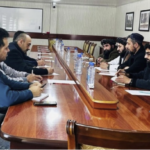After decades of hardship, conflict, and insecurity, the emergence of relative peace in Afghanistan has created an exceptional atmosphere for tourism and recreation. Blessed with breathtaking natural beauty, Afghans have always longed for the day they could breathe in peace and enjoy the mountains, rivers, lakes, historical sites, and natural landscapes of their homeland. This year’s Eid al-Adha, coinciding with the continuation of peace, presented a valuable opportunity to revive that national dream.
During the days of Eid, Afghanistan experienced a historic and unprecedented moment. Hundreds of thousands of citizens, using private vehicles, rented cars, and even on foot, traveled from their homes to various provinces and tourist destinations across the country. From north to south and east to west — from Band-e-Amir to the Panjshir Valley, from the historical and scenic city of Kabul to the mountains of Nuristan and Salang, from the valleys of Sangi Lakh and Chak in Wardak to the Darunta River, the Shah Foladi peaks, the beauty of Bamyan, and the landscapes of Helmand and Badakhshan — these areas were crowded with visitors.
Hotels, guesthouses, roads, parks, historical forts, lakes, and natural views in cities were full of joy, noise, and the cheerful presence of domestic tourists. Such a lively environment is not only a positive development for internal tourism but also sends a clear message: Afghanistan, after a long time, now stands before a new economic gateway thanks to peace. If this momentum continues, Afghanistan may become a key destination for regional and global tourists.
It is now essential for the Afghan caretaker government and the private sector not to miss this opportunity. The increasing flow of tourists can significantly boost national revenue, create employment, expand local business, promote traditional crafts, strengthen agricultural markets and the service sector, and contribute to the expression of national identity. However, all of this will only be effective if the existing shortcomings are addressed promptly.
Poor road conditions, the absence of public restrooms, weak hotel services, limited accommodation facilities, lack of clear signage and tourist guidance, unnecessary interactions at some security checkpoints, and inconsistent fee structures — these are among the challenges that must be identified and resolved by the government, provincial authorities, and private stakeholders. Listening to public feedback in this process is equally important.
Additionally, regional tourism networks should be established in every province, supported by cooperation between local communities and authorities, to provide tourists with accurate information, services, and guidance. Educational programs for youth on local culture and history, exhibitions to promote handicrafts, and public awareness campaigns for environmental conservation are all essential.
Afghanistan is not only unique in terms of natural beauty but also appeals to tourists with its historical landmarks, religious heritage, rich traditions, warm hospitality, authentic crafts, and a nation full of love and warmth. The recent surge in domestic tourism during just a few days of Eid should be a strong signal and motivation for both the government and the private sector.
It is now time for Afghanistan to view tourism as a national and strategic industry, transform it into a new source of revenue, and benefit from the experiences of global tourism. If the current progress is followed through wisely, the world will soon recognize Afghanistan as a peaceful and attractive tourist destination — an achievement that will not only drive economic growth but also reshape the country’s global image in a profoundly positive way.











